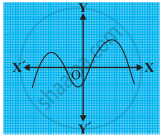Advertisements
Advertisements
प्रश्न
The number of polynomials having zeroes – 3 and 4 is ______.
पर्याय
1
2
3
more than 3
उत्तर
The number of polynomials having zeroes – 3 and 4 is more than 3.
Explanation:
The number of polynomials having zeroes – 3 and 4 are infinite or more than 3.
Required polynomials = (x + 3) (x – 4)
= x2 – x – 12
Now, we can check that any other quadratic polynomial that fits these conditions will be of the form k(x2 – x – 12).
Where k is real.
APPEARS IN
संबंधित प्रश्न
The graphs of y = p(x) are given in following figure, for some polynomials p(x). Find the number of zeroes of p(x).

Find the zeroes of the quadratic polynomial `f(x) = x^2 + 3x ˗ 10` and verify the relation between its zeroes and coefficients.
Find the zeroes of the polynomial `x^2 – 3x – m(m + 3)`
If one zero of the quadratic polynomial `kx^2 + 3x + k is 2`, then find the value of k.
If -4 is a zero of the polynomial `x^2 – x – (2k + 2) is –4`, then find the value of k.
If the sum of the zeros of the quadratic polynomial `kx^2-3x + 5` is 1 write the value of k..
Find the zeroes of the quadratic polynomial `f(x) = 6x^2 – 3.`
If ∝ and β are the zeros of the polynomial f(x) = `6x^2 + x - 2 `find the value of `(∝/β+∝/β) `
If one zero of the quadratic polynomial x2 + 3x + k is 2, then the value of k is ______.
If the graph of a polynomial intersects the x-axis at exactly two points, it need not be a quadratic polynomial.
